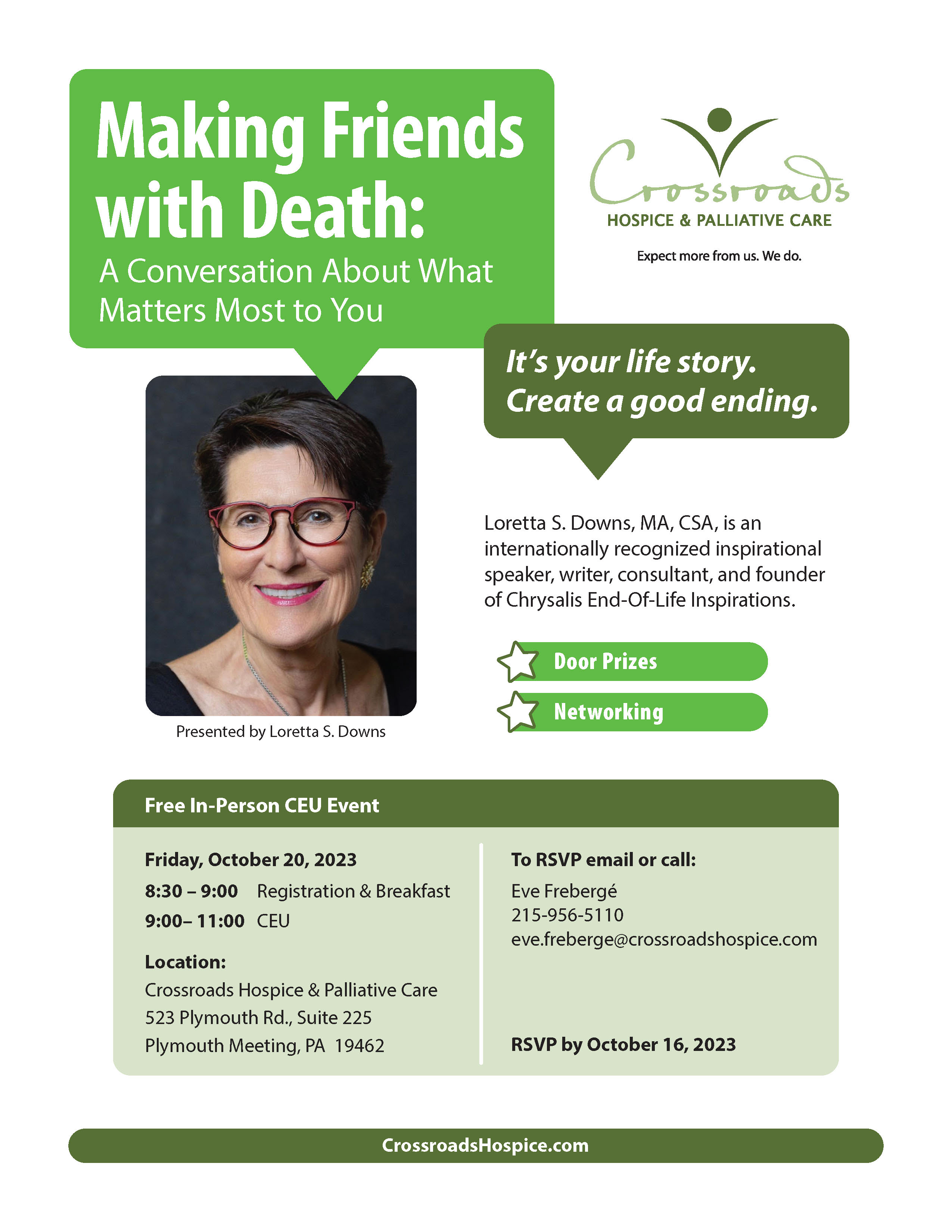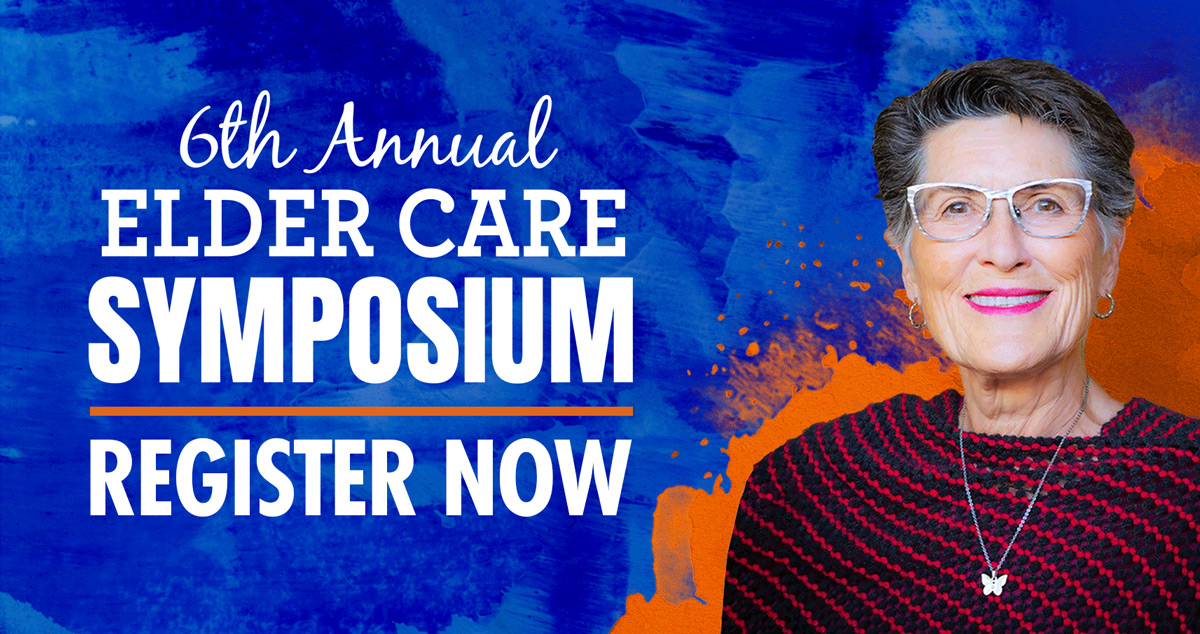Bonnie Gonzalez, Your Doula for Grief, invited me to have a conversation with her on her weekly podcast. She is a light in the darkness of the grieving process. She triggered some new ideas for me, and our conversation flowed like old friends.
Rothkoff Law Group’s Sixth Annual (Hybrid) Symposium
I’m honored to be the Keynote speaker at the Rothkoff Law Group’s Sixth Annual (Hybrid) Symposium on October 19, 2023 in Philadelphia.
Making Friends with Death: A Conversation About What Matters Most To You
I will be speaking at this free in-person event at Crossroads Hospice and Palliative Care, 523 Plymouth Rd., Suite 225 Plymouth Meeting, PA, on Friday, October 20, 2023.
To RSVP, contact Eve Frebergé, 215-956-5110 or eve.freberge@crossroadshospice.com.

6TH Annual Elder Care Symposium

Registration is open for Rothkoff Law Group’s 6th Annual Elder Care Symposium taking place on Thursday, October 19th! This year, we’re pleased to have internationally-recognized speaker, Loretta Downs, MA, CSA, deliver the keynote address during this energizing, day-long hybrid event centered around the topic of Death Is A Part Of Life: Let’s Talk About It.
Death and Taxes
Less than one-third of people have completed and executed advance healthcare directives. This article may just be the motivation you need to begin the process of considering mortality and acting on ways you can control how you are treated at the end of your life. Share it with your loved ones.
https://ojo.chapala.com/articles-2023/may-2023/death-and-taxes/
Loretta on Byte Sized Blessings Podcast
Loretta Downs featured on Butterflies and their People Website
Loretta is interviewed on the Butterflies and their People website. The interview is entitled “Giving Your Life Story a Good Ending: Loretta Downs on Monarchs, Mexico and Death”. You can read the full interview at https://butterfliesandtheirpeople.org/loretta-downs/
Watch “Eight Practices for Creating Peaceful Transitions Through Life and Death” presented by Loretta Downs
Lake Chapala Unitarian Universalist Fellowship, Ajijic, Mexico Presentation by Loretta Downs, MA, CSA on October 24, 2021
My Opening Statement, not on the video:
Facing the constant flow of changes within and around us is the universal lesson of impermanence. How we perceive, how we cope, and how we process the resulting transitions creates the state of dis-ease or ease in which we live our lives. Loretta will talk to us about eight practices that will help make those transitions more manageable and more peaceful for us and for others involved.
My Closing Statement, not on the video:
Let us allow ourselves to forgive our inability to be perfect, our failures to rise to every occasion, our lack of awareness, our seemingly bottomless pit of self-abuses. Let us embrace these oh-so-human conditions as inspiration to be intentional in our search for peace and happiness in ourselves and model it for the entire world.
Katy Butler’s “The Art of Dying Well, A Practical Guide to a Good End of Life” includes a section devoted to The Chrysalis Room
Author Katy Butler wrote a groundbreaking expose’ of modern medicine, Knocking on Heaven’s Door, The Path to a Better Way of Death in 2013. The Chicago End-of-Life Care Coalition sponsored a book signing event on her national tour. As President, I spent the day with Katy and we talked about end of life issues, including my Chrysalis Room concept.
I am proud to announce that in her new book, The Art of Dying Well, A Practical Guide to a Good End of Life, she devotes a section to The Chrysalis Room:
Chapter 7 Active Dying, Preparing in a Nursing Home
“If someone you love is dying in a nursing home, ask for a temporary private room. (You may not prevail, but it never hurts to ask.) Or improvise.
When Loretta Downs’s mother was dying in a nursing home in Chicago in 2006, Loretta got permission to transform an unused storage room into a sacred, private space, which she decorated with her mother’s possessions. Friends and family came to share their memories and bring food, and other residents dropped in to say goodbye.
Loretta, an experienced hospice volunteer with a professional background in interior design, named the space she’d created the “Chrysalis Room” after the pupa that holds a caterpillar as it is transformed into a butterfly. The room became a permanent and beloved feature of the nursing home and set in motion a cultural shift.
Before the room was arranged, nursing home staff feared death—and the crowded conditions in which it was taking place—and sent most dying residents to the hospital. Only a few died in the nursing home under hospice care, and their families were forced to keep vigil in a room barely big enough to allow one relative to sit comfortably at the bedside. As soon as the resident died, the room would be emptied and the body taken away. The person would silently disappear from the community they’d long called home, as if they had never lived.
After the Chrysalis room opened, more residents enrolled in hospice care prior to death, and more died in the place that had become their “home,” rather than in a hospital. Other residents became more likely to participate in the final goodbyes, and some became less fearful of their own deaths.
Downs has since helped create similar Chrysalis rooms in nursing homes in Wyoming, Indiana, and the Chicago suburbs. The ideal spaces, she says, are quiet, with natural light, a view of nature, floor lamps, an adjustable bed, a recliner, soft music, and folding chairs. But with a little imagination, almost any private space can be made more humane than a shared room. For more information on how to improvise or build a Chrysalis room, consult Downs’ endoflifeinspirations.com.”
Order the book on Amazon.
“Making Friends With Death” Article in El Ojo Magazine
I recently published an article entitled “Making Friends with Death” in the expat magazine El Ojo.
You can read the article at https://www.chapala.com.
